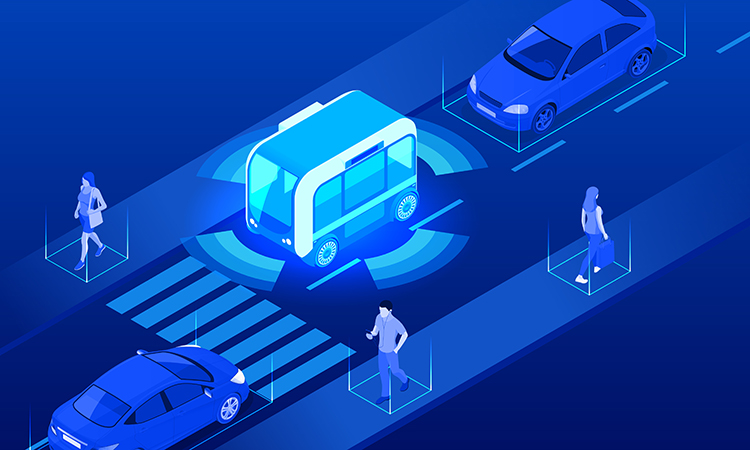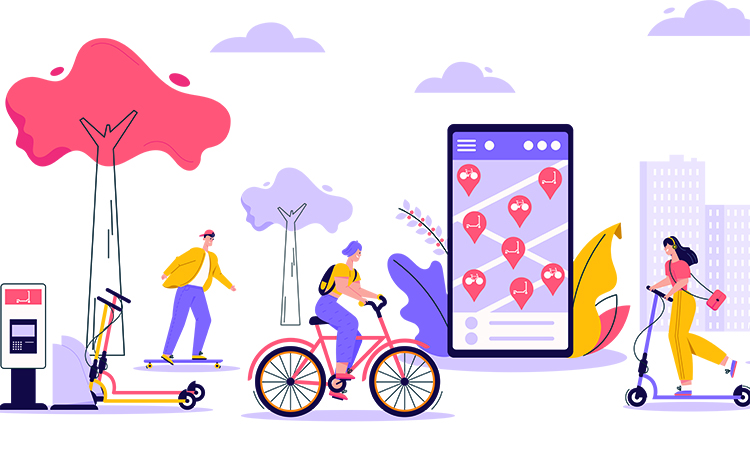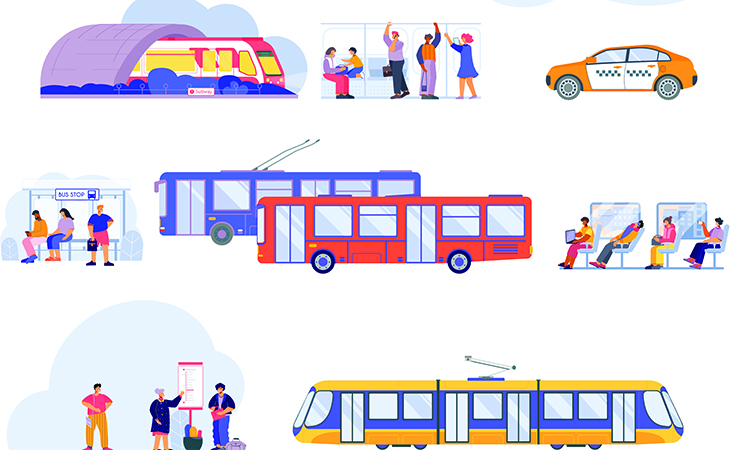Considering the future of mobility
- Like
- Digg
- Del
- Tumblr
- VKontakte
- Buffer
- Love This
- Odnoklassniki
- Meneame
- Blogger
- Amazon
- Yahoo Mail
- Gmail
- AOL
- Newsvine
- HackerNews
- Evernote
- MySpace
- Mail.ru
- Viadeo
- Line
- Comments
- Yummly
- SMS
- Viber
- Telegram
- Subscribe
- Skype
- Facebook Messenger
- Kakao
- LiveJournal
- Yammer
- Edgar
- Fintel
- Mix
- Instapaper
- Copy Link
Posted: 15 December 2022 | Intelligent Transport | No comments yet
For Intelligent Transport, a panel of public transport experts have come together to share their thoughts on what they think the future of mobility may look like, as well as offer their predictions on what they expect the most significant trend to impact the industry will be in the next five years.


Participants
  |
  |
  |
  |
|
John Andoh Mass Transit Administrator & General Manager at the |
Georgia Corr
Public Policy Manager – UK and Ireland at |
Sara Davidson Senior Technical Lead – Emerging Technologies & Innovative Mobility at the Intelligent Transportation Society of America (ITS America) |
Kammy Horne
Senior Vice President – Development at |
  |
  |
  |
  |
|
Michael Kodransky
U.S. Director at the |
Steve Longman
Mobility-as-a-Service Project Manager at |
Marla Westervelt
Previously the Vice President of Policy at the |
Georgia Yexley General Manager – UK & Ireland at TIER Mobility |
What do you think will be the most significant trend to impact the mobility industry in the next five years?
Diversification of the movement of people will become the norm of public transit agencies in order to create equitable opportunities”




Many cities are ramping up their efforts to adopt policies to encourage more people to break up with cars and turn to shared, sustainable and carbon-free transport options”
To encourage more people to adopt a car-free lifestyle, investment in active travel infrastructure is essential to pave the way for cycling and scooting to become the natural transport choice for short journeys – particularly as we know that the key barrier across all groups relates to motor traffic safety concerns.
We’ve already seen local authorities and cities nationally introduce segregated cycle lanes, junction improvements and Low Traffic Neighbourhoods that create healthier, safer streets where all members of society can feel empowered to travel sustainably.
However, we also need to recognise that infrastructure alone won’t break our addiction to cars. With unprecedented levels of toxic air pollution in our cities, we need more policies that seek to discourage the use of private cars for short journeys, too, like the introduction and expansion of Clean Air Zones. I think that we’re only going to see more of these policies in the coming years, and they have significant potential to encourage the widespread adoption of micro-mobility services.
Ultimately, cars do not have an inherent right to our streets. Every city and town can encourage the adoption of micro-mobility by putting people and our planet ahead of cars.
Looking forward, our ability to leverage real-time information and transformational technologies to improve transportation service and inform decision‑making will continue to grow”




As the impacts of COVID-19… lessen and more traffic returns to the roadways, the congestion that has always been projected… will be realised and will make public transportation an even more attractive option”




Vehicle technology alone will not get us below the dreaded global climate threshold danger line. Mitigation measures are also needed”
The COVID-19 pandemic focused the world’s attention on how communities exposed to air pollution are especially vulnerable to getting sick from airborne diseases, especially those living or working near corridors with high concentrations of toxic exhaust. Pollutants from tailpipe emissions are a menace to the health and well-being of everyone, but especially to marginalised communities who are burned with environmental injustice.
Electrification is a great opportunity to adapt our existing mobility systems to address the climate-equity-public health crisis. Yet, vehicle technology alone will not get us below the dreaded global climate threshold danger line. Mitigation measures are also needed. Compact, mixed-use development policies around multimodal, clean transport systems can be a blueprint for thriving climate resilient communities, supporting less energy intensive trips for people, as well as more efficient goods delivery. That will be the trend within this decade.
With the increasing trend of subscription and on-demand access to a variety of modes… young people of today won’t have the barrier of making a large upfront investment to get their personal freedom”




As public agencies seek to direct private companies towards operating in the public interest, we will see an increased need to build regulatory and funding structures that align public and private interests”
As public agencies seek to direct private companies towards operating in the public interest, we will see an increased need to build regulatory and funding structures that align public and private interests. Policymakers have the opportunity to harness the value of private services through thoughtfully designed regulation, or risk that potential of regulating private operators out of existence. If policymakers grasp the opportunity, the mobility industry will see positive change — and faster than ever before — in the next five years.


With this broad-scale shift towards e-bikes and e-scooters for personal and for business mobility, there swiftly follows an increase in demand and need for high quality infrastructure dedicated to these vehicle types. This means segregated cycle lanes, parking solutions for shared and privately owned e-bikes and e-scooters, and other changes to our urban landscape.
We also expect to see a better connected ‘mesh’ of different modes of transport, where users will easily be able to start and/or end a journey using micro-mobility, linking up public transport, taxis or shared vehicle services”
Looking more specifically at shared micro-mobility, the technology underpinning our service is going to continue to mature. TIER Mobility is running a pilot of our first in-house developed ‘brain’ for our e-scooters in London at the moment, which features more powerful internals and better connectivity. We are developing new use-cases based on the improved capabilities of this brain and, over the next five years, we expect to see more advanced safety systems and an improved user experience.
We also expect to see a better connected ‘mesh’ of different modes of transport, where users will easily be able to start and/or end a journey using micro-mobility, linking up public transport, taxis or shared vehicle services. TIER e-scooters and e-bikes are already available through mobility apps like FREE NOW and Moovit, and more of these partnerships will let consumers access a range of different modalities through a few core apps and touchpoints, making it easier for people to choose the best way to get around on a daily or even minute-by-minute basis. We know that micro-mobility helps to extend the reach of public transport services, and working together provides a more robust service than individually.
If there is just one ‘trend’ that makes the most significant change, I am hopeful that it will be the strengthening of collaboration across the private and public sector; to be joint value creators for public good.


What do you think the future of mobility looks like?




We’ve already started to see pioneers like Paris and London take away space from cars for more efficient transport options.
Cars not only sit idle for over 95 per cent of the time, but carry very few people, with England’s average car occupancy in 2020 being just 1.5 people1. The future of mobility is one where more cities take action to repurpose space from cars towards more efficient, green transport options, such as public transport and micro‑mobility.


- Automated vehicles (AVs): Advancements in AVs, and associated opportunities to reimagine the design of driverless vehicles to incorporate more universal design elements, can potentially provide additional transportation accessibility and independence to a wide range of travellers, including individuals with disabilities
- Mobility-on-Demand (MOD): Evolving shared-use and on-demand-related deployments and partnerships can increase local mobility options, support improved first-/last-mile mobility and expand the reach of existing mobility networks – for instance, MOD can help to extend transit service hours and service area to better connect with a broader range of travellers (such as late-night workers or individuals in underserved areas or transit deserts). MOD services can serve as a dynamic tool to advance need-responsive, timely access to transportation
- Mobility wallets: The development and expansion of systems for integrated, account-based trip payment can potentially help to connect qualified travellers with ‘best fares’ or subsidised rides, whilst also supporting more seamless trip chaining and multimodal travel for all
- Assistive technologies: Emerging tools and technologies can be leveraged to further improve navigation and tailored trip planning/decision-making to advance mobility for travellers with a diverse range of needs across the complete trip
- Complete Streets: Changes associated with how street and curb space is delegated and designed can help to improve safety for pedestrians and multimodal travellers, making these modes safer and more accessible.
If these changes and innovations are deployed thoughtfully, the future of mobility will present travellers with increased transportation freedom and flexibility, supported by greater access to safe, potentially more sustainable modes, travel information, tools and spaces that promote accessible multimodal travel.




The future of mobility is trending toward enhancing the long-time benefits and innovation of public transportation, while modernising infrastructure and modes to deliver an improved public service that’s flexible enough to fit diverse needs and preferences while, at its core, designed to move more people, faster and farther.


Within the last 20 years, the Cheonggyecheon highway was torn down in Seoul, South Korea – demonstrating new thinking about mobility to the world. Instead of maintaining an elevated highway with endless traffic congestion and smog, Seoul transformed the corridor into a delightful naturalistic public space, uncovering a buried waterway and connecting adjacent neighbourhoods with improved walking paths and bus links. In the midst of the COVID-19 pandemic, and to provide urban dwellers with some relief from sheltering-in-place, cities began to pilot open streets for restaurant use, public gathering and to give priority to pedestrians, bike users and bus riders. Campaigns such as NYC25x25 and LA25x25 in the top two most populous U.S. regions call for reclaiming 25 per cent of urban road space, usually from on-street parking, to make way for many other uses by 2025.
The future will include less limited access roads, better management of existing surface mobility assets and more universal basic mobility programmes that connect people through affordable digital mobility wallets to opportunities and destinations. There will be more ways to get around using emerging transport modes with real-time information, connecting people and goods. Most importantly, there is growing awareness about how transport system designers do not always reflect the needs of all system users, especially the disabled, women, children, elderly and others. The future will bring greater mobility access to all users through more inclusive design approaches.


How and why we travel is deep into large scale change through new modes, new business models, changing behaviours and beliefs, as well as developing technology. With all of this potential opportunity (and challenges) ahead, it is essential to adopt a human-centric focus to the decisions and planning of our transport system to meet society’s needs.
There’s some impressive mobility-related technology out there, but we must take an impartial view on whether or not that technology meets the objectives of society – rather than trying to find a problem to fit the shiny new technology-based solution. Similarly, with new business models, the solution needs to work not just for the operator, but also the myriad of different users and their needs. The days of focusing a model on the traditional commute is behind us, and this needs to be mirrored in our future transport system.
So, when I say that mobility should be unimportant in the future, I mean that it shouldn’t be a barrier to our happiness. We have an enormous opportunity to evolve our transport system and make it work better for everyone. Identifying and addressing the pain points from a holistic user perspective will help to create an environment where transport is less of an obstruction to opportunities and is inconspicuous. I don’t want using transport to stress me out, to prevent me from attending an event or opportunity, or for planning how I’m going to get somewhere to be complicated. Basically, as a user, I don’t want to have to think about using transport.


Policymakers have the opportunity to define regulatory and funding structures that prioritise people and the planet. One of the ways to do that is to ensure that everyone has at least two transport options to get where they want to go, when they need to get there. Here at the Coalition for Reimagined Mobility, we believe that transportation is a public good, regardless of whether it comes from public or private sectors. At the end of the day, it’s up to policymakers to have these conversations and work together to better serve the public’s interest.


Urban populations are projected to only increase, and the way that we live and work has just undergone a dramatic and sudden shift. With the traditional financial engine of public transport – commuting – being reduced, while journeys in the local areas around where people live has increased, bringing with it increased car traffic, and with online shopping deeply entrenched in people’s lifestyles, there are more and more delivery vehicles on our streets than ever before.
We can’t widen the streets in our cities, especially in the centre of cities like London or Paris, which are hundreds of years old. And, even if we could widen the streets, this would only induce demand and make the issue worse. Something has to give and, for the sake of our health and environment, it must be the reallocation of space away from the car. The reason why the micro-mobility industry is so exciting is how much of an impact it has made whilst still being very young. Legislation is playing catch-up, and we are really only seeing the beginning of what light electric vehicles like e-scooters or pedal‑assist bicycles and cargo-bikes can do.
To get people out of their cars, there needs to be an easy-to-access alternative, and this is where shared mobility and better integration of services steps in. In the future, the flexibility and ease of use of shared services will trump the benefits of owning and using a private car. The future is looking distinctly bicycle and e-scooter shaped!
References
- Taken from DfT Vehicle Occupancy data – https://assets.publishing.service.gov.uk/government/uploads/system/uploads/attachment_data/file/1017064/nts0905.ods
Related topics
Accessibility, Air Quality, Alternative Power, Connected & Autonomous Vehicles, COVID-19, Fleet Management & Maintenance, Infrastructure & Urban Planning, Intelligent Transport Systems (ITS), Journey Planning, Micro-mobility, Mobility Services, Multimodality, On-Demand Transport, Passenger Experience, Public Transport, Sustainable Urban Transport, Ticketing & Payments, Traffic Management, Transport Governance & Policy, Travel & Passenger Information, Vehicle & Passenger Safety
Issue
Issue 3 2022
Related modes
Bikes & Scooters, Bus & Coach, Ferry, Rail, Ride-sharing & Car-sharing, Taxi
Related organisations
Coalition for Reimagined Mobility, County of Hawai’i Mass Transit Agency (Hele-On), Department for Transport (DfT), Hawai’i County Council, Institute for Transportation and Development Policy (ITDP), Intelligent Transportation Society of America (ITS America), Lime, Lyft, Solent Transport, TIER Mobility, Uber, VIA Metropolitan Transit
Related people
Georgia Corr, Georgia Yexley, John Andoh, Kammy Horne, Marla Westervelt, Michael Kodransky, Sara Davidson, Steve Longman








